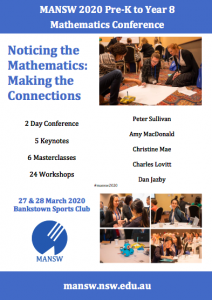Keeping up with current research is an essential part of any teacher’s pursuit for improving practice. Our learning isn’t over once we graduate from university, in fact it is only just beginning. Although much of teaching is about on-the-job learning, we must also continue to adapt our teaching to suit the differing needs, interests and abilities of our students. Change requires knowledge of what works, successful classroom practice influences research and research in turn effects classroom practice.
Within the last week I received many emails regarding new research articles published by both Australian and International researchers who I follow the work of via subscriptions to journals. Even if teachers don’t have time to join such groups, like ResearchGate, social media like Twitter allow teachers to access quality research that could impact on their own classroom practice.
Out tomorrow: The 'ins' and 'outs of student engagement in mathematics: shifts in engagement factors among high and low achievers- published in MERJ (Springer) by Skilling @OxfordDeptofEd @ @janettebobis @Sydney_Uni and A.J. Martin @UNSW. Please DM me for copies. pic.twitter.com/jLhDQVVFtP
— Dr Karen Skilling: Sydney; London; Oxford (@karen_skilling) February 20, 2020
Our promising study showing primary teachers value allowing time for students to struggle when learning mathematics. Download it here: https://t.co/XbY06K9FqX #growthmindset @joboaler @MonashEducation @helenjwc @janettebobis @A_Mac_D_ @kath_cartwright @tobyrusso @sharynlivy
— James Russo (@surfmaths) March 4, 2020
Technology-enabled Mathematics Education. Excited to be launching our book tonight @KathHol @westernsydneyu @westsydunews @WSU_CER @aamtinc @MathsNSW @RoutledgeEd @RoutledgeEOE pic.twitter.com/w67LDILxjk
— Dr Catherine Attard (@attard_c) March 4, 2020
Karen Skilling (@karen_skilling), Janette Bobis (@janettebobis) and Andrew Martin published a journal article this month about student engagement in mathematics. Their research involved students in the early years of secondary school, asking them about their engagement and motivation in mathematics as they transitioned between primary and secondary school. The students were categorised into four groups: high achieving engaged, low achieving engaged, high achieving disengaged, and low achieving disengaged. The discussion of the groups’ data along with individual student cases is essential reading for all teachers of mathematics.
“Irrespective of achievement levels, engaging students believed that mathematics was an
important subject to study at school and valuable for their future.”
page 19, The “ins and outs” of student engagement in mathematics: shifts in engagement factors among high and low achievers
“For students who have experiences of repeated failure at mathematics and attribute this
to their ability, they may see little value in expending effort to improve.”
Discussing disengaging students, page 21, The “ins and outs” of student engagement
in mathematics: shifts in engagement factors among high and low achievers
James Russo (@surfmaths) published a new article recently with colleagues Janette Bobis (@janettebobis), Ann Downton (@AnnDownton), Hughes, S., Livy, S., McCormick, M., and Sullivan, P. on teachers’ beliefs on the role of struggle in the mathematics classroom. They highlight that the purpose of productive struggle in the classroom is to enable students to have a growth mindset approach to learning. Struggle brings to the fore the need for thinking, deep thinking, and the benefits that thinking has on the way we learn and what we learn.
“The most frequently cited benefits of struggle were the opportunities it provided students to persist through challenge, take risks, build autonomy, develop confidence, foster self-efficacy, learn through mistakes, and acquire a growth mindset.”
page 11, Elementary teachers’ beliefs on the role of struggle in the mathematics classroom
Russo and colleagues’ article is based on what current classroom practitioners are experiencing and the value that allowing students to wrestle with knowledge and think hard about a task has on learning. It is this type of current pedagogical research that should be influencing our teaching strategies.
Catherine Attard (@attard_c) and Kathryn Holmes (@KathHol) this week launched their book Technology-enabled Mathematics Education and optimising student engagement. Their book explores case studies of how teachers of mathematics are using technology to enhance student engagement in the classroom. The book shares tools, and pedagogical practices to embed technology in authentic ways to optimise student engagement.
These are just three examples of quality of mathematics education research appearing each week. Keeping current with reading research not only introduces teachers to new strategies and ideas, but also often confirms the practices we are already implementing. Another way to access current research and classroom practice is through attending conferences. As a member of MANSW @MathsNSW (Mathematical Association of NSW) I would highly recommend their upcoming conference for Pre-Kindergarten to Year 8 teachers on Friday 27 & Saturday 28 March. Information about the conference and registration can be accessed here. The focus of the two-day conference is Noticing the Mathematics: Making the Connections.
The MANSW PreK-8 conference has a huge line-up of great speakers – both researchers and practicing teachers. Speakers include; Amy MacDonald, Peter Sullivan, Charles Lovitt, Dan Jazby, Christine Mae, Peter Gould, Catherine Attard, Jenni Way, Janette Bobis, Lorraine Day, Derek Hurrell, Ruth Glasgow, Jake Little, Fiona Foley … come along and keep up with the current!
References
Attard, C., & Holmes, K. (2019). Technology-enabled Mathematics Education: Optimising Student Engagement. Routledge.
Russo, J., Bobis, J., Downton, A., Hughes, S., Livy, S., McCormick, M., & Sullivan, P. (2020). Elementary teachers’ beliefs on the role of struggle in the mathematics classroom. The Journal of Mathematical Behavior, 58, 100774.
Skilling, K., Bobis, J., & Martin, A. J. (2020). The “ins and outs” of student engagement in mathematics: shifts in engagement factors among high and low achievers. Mathematics Education Research Journal, 1-25.






